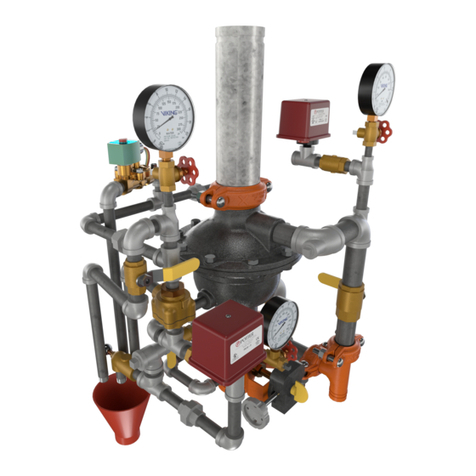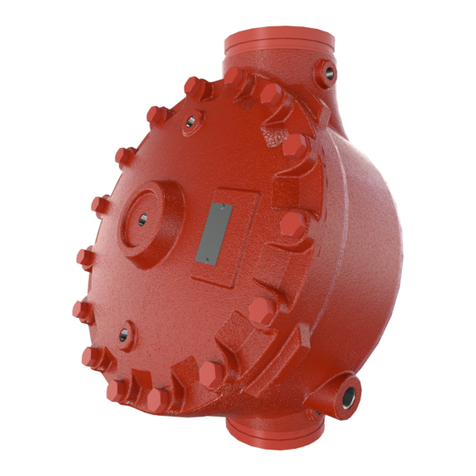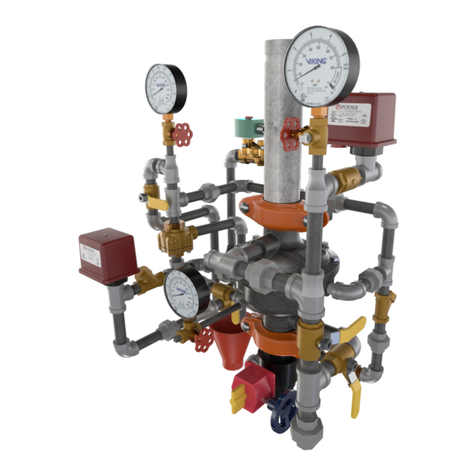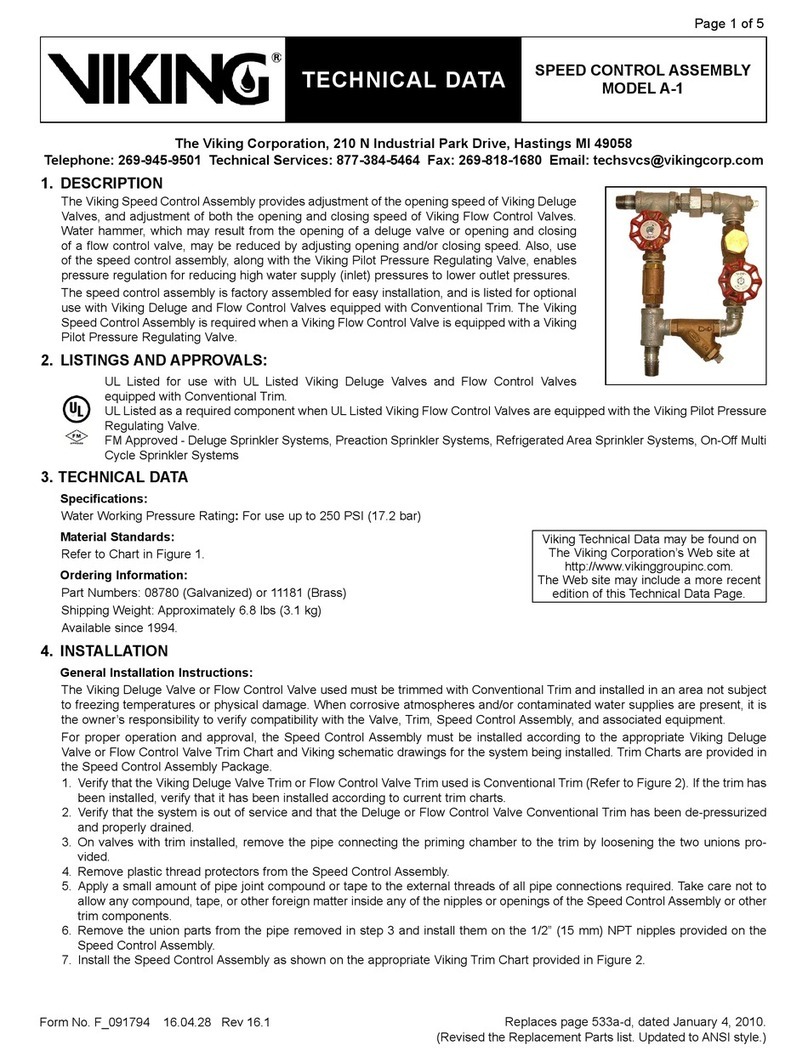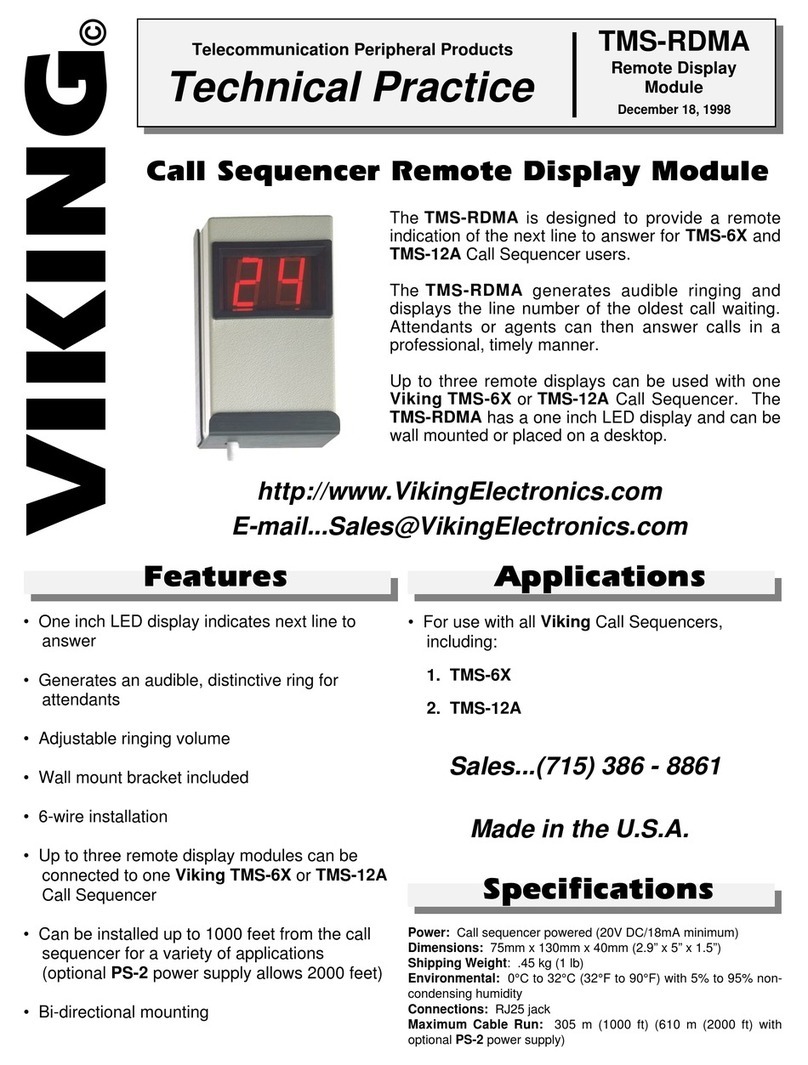
TECHNICAL DATA DELUGE VALVE
MODEL VXD
The Viking Corporation, 210 N Industrial Park Drive, Hastings MI 49058
T
elephone:
269-945-9501
T
echnical
Services:
877-384-5464
Fax:
269-818-1680
Email:
[email protected]Visit the Viking website for the latest edition of this technical data page www.vikinggroupinc.com
Page 4 of 13
Form No. F_012120 21.10.163 Rev 21.1
4 INSTALLATION
General Information
1. Viking Deluge Valves may be installed in the horizontal or vertical position.
2. The valve must be installed in an area not subject to freezing temperatures or physical damage.
3. The valve must be trimmed according to current Viking Trim Charts and appropriate instructions for the system used. Trim
Charts are available on the Viking website, and are provided with trim packages.
4. Remove all plastic protectors from the openings of the Deluge Valve.
5. Apply a small amount of pipe joint compound or tape to the external threads of all pipe connections required. Take care not to
allow any compound, tape, or other foreign matter inside any of the nipples or openings of the valve or trim components.
6. Verify that all system components are rated for the water working pressure of the system.
7. Hydrostatic Test:
The Model VXD Deluge Valve is manufactured and listed for use at a maximum Water Working Pressure of 250 PSI (17.2
bar). The valve is factory tested at 500 PSI (34.5 bar). The valves may be hydrostatically tested at 300 PSI (20.7 bar) and/
or 50 PSI (3.5 bar) above the normal Water Working Pressure, for limited periods of time (two hours), for the purpose of
acceptance by the Authority Having Jurisdiction.
TRIM NOTE: DISCHARGE PIPING FROM THE FLOW TEST VALVE AND ALL SYSTEM DRAINS SHOULD BE KEPT
SEPARATE.
8. The priming line must be connected upstream of the system water supply main control valve or to a constant source of water
at a pressure equal to the system water supply.
9. After the Deluge Valve is set, operation of the Deluge Valve requires the release of priming water from the priming chamber.
This may be by automatic or manual operation of the release system. Model VXD Deluge Valves are compatible with hydraulic,
pneumatic and electric release systems.
a. Hydraulic Release Systems: See Figures 12-16 for the maximum allowable elevation of hydraulic release piping above the
Deluge Valve. If the maximum height of hydraulic release piping exceeds the limit shown in Figures 12-16 for the valve
used, use a Pneumatic or Electric Release System
b. Pneumatic Release Systems: A Viking Pneumatic Actuator is required between the release system connection provided on
deluge valve trim and pneumatic release Piping.
c. Electric Release: Solenoid Valves, System Control Panels, and Electrical Detectors must be compatible. Consult
appropriate listing and/or approval guides.
CAUTION
Operation of Viking Deluge Valves by pressurizing the priming chamber with air pressure or any other pressurized
gas is not recommended or approved.
5 OPERATION
The Viking Model VXD Deluge Valve has an inlet chamber, an outlet chamber and a priming chamber. The inlet chamber and outlet
chamber are separated from the priming chamber by the diaphragm.
In the set condition:
System pressure is supplied to the priming chamber through a restricted priming line (trim) equipped with a check valve. System
water supply pressure trapped in the priming chamber holds the diaphragm in the closed position due to area differential design. The
Diaphragm separates the inlet chamber from the outlet chamber, keeping the outlet chamber and system piping dry.
In fire conditions:
When the release system operates, pressure is released from the priming chamber faster than it is supplied through the restricted
into the system and alarm devices.
The inlet side of the PORV is connected directly to the top chamber of the deluge valve. In the set position, pressure is supplied to the
inlet. The pressure on the push rod prevents water from escaping. When the deluge valve operates, water is drained from the PORV
will continue to escape through the PORV, allowing the deluge valve to continue to operate until the system is reset.


